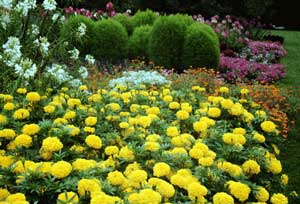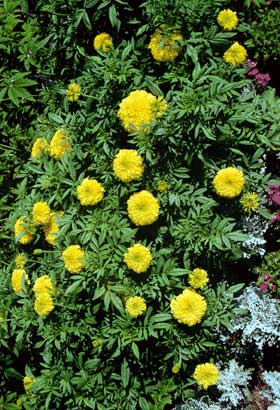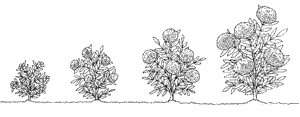 |
Marigolds are a staple of American yards. These easy, sturdy annuals bloom profusely and reliably over the summer, culminating in a splendid show during the cooler days of autumn.
 |
As a group marigolds are very easy to grow. They are suitable for borders, beds, cut flowers, and containers. Some vegetable gardeners even plant them among their food plants, believing that the strong smell of their foliage and a chemical in their roots repel certain pests.
Size of Marigolds: There is considerable variation in height within each group of marigolds. However, American ones are the tallest, growing from between 10 to 36 inches tall. The French types tend to be from 6 to 18 inches, while the triploids, a cross between these two, are generally from 12 to 20 inches tall. Signet marigolds are the smallest, usually reaching about 8 inches. At maturity individual marigold plants typically become quite bushy. The plants of taller marigold varieties may reach 24 inches in width, the smaller ones, 10 inches.
 |
Foliage of Marigolds: Marigolds have dark green feathery foliage. Individual leaves have a fine-textured look because they are compound--pairs of tiny, toothed leaflets growing opposite each other along the main leaf stem and one leaflet at the tip. Marigold foliage is notorious for its distinctive, musky odor, although some hybrids are odorless. Signet types have finer, ferny foliage with a pleasant lemon scent.
Flowers of Marigolds: Marigolds bloom from early summer to first frost. They have a slightly sweet fragrance that, except for the signet types, is usually overwhelmed by their strong foliage scent. Blossoms can be pure white to ivory, gold, orange, to yellow and peach. Some of the French types and some hybrids are bicolored--reddish-brown with orange or yellow. The French types may have single flowers such as the Disco Mixed variety, or double flowers. They are typically about 1 1/2 inches across. American and triploid blooms have large double flowers that resemble carnations. Some are as large as 4 to 5 inches in diameter.

